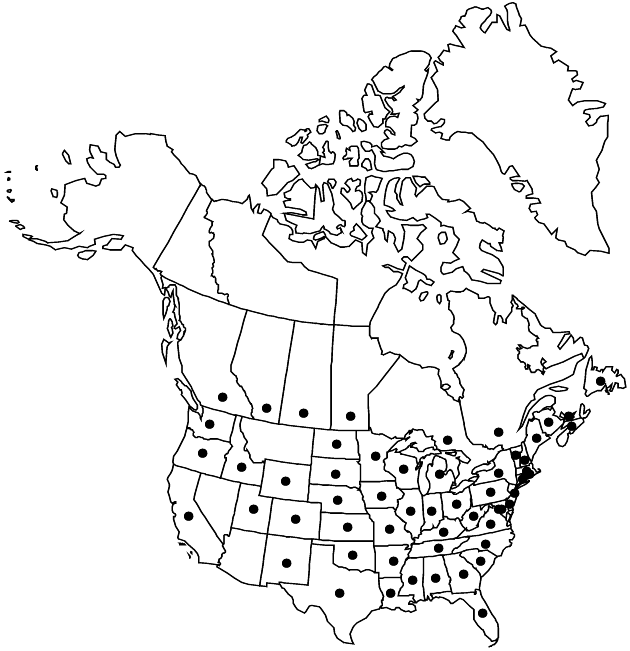Rudbeckia hirta
Sp. Pl. 2: 907. 1753.
Annuals, biennials, or perennials, to 100 cm (taprooted or roots fibrous). Stems hispid to hirsute (hairs spreading, 1+ mm). Leaves: blades elliptic, lanceolate, or ovate (not lobed), bases attenuate to cuneate, margins entire or serrate, apices acute, faces hispid to hirsute; basal petiolate, blades 8–30 × 0.5–7 cm; cauline petiolate or sessile, blades (sometimes pandurate) 3–20 × 0.4–4 cm. Heads borne singly or (2–5) in loose, corymbiform arrays. Phyllaries to 3 cm (faces hispid to hirsute). Receptacles hemispheric to ovoid; paleae 4–6 mm, apices acute, often attenuate, abaxial tips hirsute to hispid. Ray florets 8–16; laminae (usually uniformly yellow to yellow-orange or with a basal maroon splotch, sometimes mostly maroon) elliptic to oblong or oblanceolate, 15–45 × 5–10 mm, abaxially hispid to hirsute. Discs 12–22 × 10–20 mm. Disc florets 250–500+; corollas proximally yellowish green, distally brown-purple, 3–4.2 mm; style branches ca. 1.5 mm, apices subulate. Cypselae 1.5–2.7 mm; pappi 0.
Distribution

Alta., B.C., Man., N.B., N.S., Nfld. and Labr. (Nfld.), Ont., P.E.I., Que., Sask., Ala., Ark., Calif., Colo., Conn., D.C., Del., Fla., Ga., Idaho, Ill., Ind., Iowa, Kans., Ky., La., Maine, Mass., Md., Mich., Minn., Miss., Mo., N.C., N.Dak., N.H., N.J., N.Mex., N.Y., Nebr., Ohio, Okla., Oreg., Pa., R.I., S.C., S.Dak., Tenn., Tex., Utah, Va., Vt., W.Va., Wash., Wis., Wyo.
Discussion
Varieties 4 (4 in the flora).
Some strains of Rudbeckia hirta are cultivated and/or used in seed mixes for “re-naturalization” and erosion control.
Selected References
None.
Lower Taxa
Key
| 1 | Annuals, biennials, or perennials; stems branched at bases or proximal to or at or near mid heights, leafy mostly toward bases (leaves smaller distally); peduncles usually at least 1/2 plant heights (Gulf Coastal Plain, Florida to Texas) | > 2 |
| 1 | Biennials or perennials; stems branched mostly beyond mid heights, leafy ± throughout; peduncles to 1/3 plant heights | > 3 |
| 2 | Stems branched mostly at or near mid heights; basal leaves oblanceolate, faces hispid to ± sericeous; Georgia to Texas | Rudbeckia hirta var. angustifolia |
| 2 | Stems branched at or near bases (plants often scapiform); basal leaves obovate to nearly orbiculate, faces scabrous to hirsute; c, s Florida | Rudbeckia hirta var. floridana |
| 3 | Leaves: basal blades broadly ovate to broadly elliptic, 2.5–7 cm wide (lengths mostly 2 times widths), margins coarsely toothed; cauline (sometimes sessile) lanceolate, ovate, or pandurate (mostly Appalachian Highlands toIllinois) | Rudbeckia hirta var. hirta |
| 3 | Leaves: basal blades lanceolate to oblanceolate, 1–2.5(–5) cm wide (lengths 3–5 times widths), margins entire or serrulate; cauline blades spatulate, oblanceolate, or broadly linear | Rudbeckia hirta var. pulcherrima |